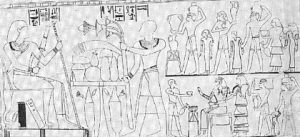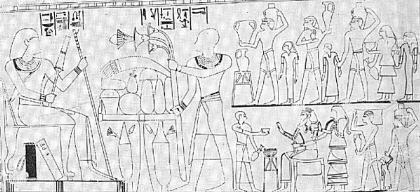Introduction
Medicine in ancient Egypt was but one aspect of an advanced civilization. It was not practiced by witch doctors as in primitive tribes, with mixture of magic, herbal remedy, and superstitious beliefs. This was acknowledged by Homer in the Odyssey:
“In Egypt, the men are more skilled in Medicine than any of human kind”.
Sovereigns from foreign lands have frequently appealed to pharaohs to send them their physicians. A wall painting in a Thebean grave of the 18th dynasty (1400 BC) depicts “Nebamun”, scribe and physician of the king, receiving a Syrian prince paying him for his services in gifts. According to Herodotus, King Cyrus of Persia has requested Amasis (Ahmose II of the 26th dynasty, 560 BC) to send him the most skilful of all the Egyptian eye-doctors.
. 
“Nebamun”, scribe and physician of the king, receiving a Syrian prince paying him for his services in gifts
MEDICAL PAPYRI:
Some kind of medicine was already practiced in Egypt in the earliest prehistoric days, (the use of malachite as an eye paint in the Badarian age – around 4000 BC, and the same use of galena in predynastic times). The oldest yet discovered papyrus is the “Kahun Gynecology Papyrus”, dating back to 1825 BC, during the reign of Amnemhat III. It describes methods of diagnosing pregnancy and the sex of the fetus, toothache during pregnancy, diseases of women, as well as feminine drugs, pastes and vaginal applications.
The most famous and elaborate papyri are the “Edwin Smith Papyrus” (1600 BC) and the “Ebers papyrus”, which refers to King Den (1st dynasty, 3000 BC), suggesting a much earlier origin.

The Edwin Smith Papyrus.
“The book of …….. was found in writings under the two feet of Anubis in Letopolis and was brought to the majesty of the king of Upper and Lower Egypt Den.”
The Edwin Smith Papyrus is 5 meters long, and is chiefly concerned with surgery. It described 48 surgical cases of wounds of the head, neck, shoulders, breast and chest. Unfortunately, the scribe who copied it did not proceed further from the thorax, and it ended abruptly in the middle of a sentence. The papyrus listed the manifestations, followed by prescriptions to every individual case. It included a vast experience in fractures that can only be acquired at a site where accidents were extremely numerous, as during the building of the pyramids. The Ebers Papyrus is a huge roll of more than 20 meters long and 30 cm wide. It is chiefly an internal medicine reference, as well as diseases of the eye, skin, extremities, gynecology and some surgical diseases. Anatomical and physiological terminology are also included. For treatment of those diseases, 877 recipes and 400 drugs were described.
THE CAUSES OF DISEASES, ANATOMY AND PHYSIOLOGY:
The human body was believed to be born in a healthy state, and could not fall ill or die except through the influence of a foreign agent. In case of wounds or intestinal worms, that agent was visible and the treatment prescribed was hence rational. As they were not aware of microbiology, internal diseases were thought to be due to an occult force attributed to evil gods, a divine punishment or magical procedures. The physician was obliged to neutralize this evil before turning into actual treatment.
Despite such limitation in their knowledge of the causes of diseases, their study of anatomy and physiology was so advanced. No doubt, this was due to their embalming of the dead, when other nations at that time used to burn them. For instance, the process of emptying the skull through the nostrils by means of a long hook could have never been devised without a good knowledge of the anatomy of the head and brain. In our modern medicine, many brain surgeries are nowadays performed through this route. They obtained a good knowledge of the meninges, the cerebrospinal fluid, and the twitches and pulsations, and were aware that the brain was the seat of the body control.
"If thou examines a man having a gaping wound in his head penetrating to the bone, smashing his skull, and rending open the brain of his skull, thou shouldst palpate his wound. Shouldst thou find that smash which in his skull like those corrugations which form in molten copper, and something therein throbbing and fluttering under thy fingers, like the weak place of an infant's crown before it becomes whole- when it has happened there is no throbbing and fluttering under thy fingers until the brain of his skull is rent open and he discharges blood from both his nostrils, and he suffers with stiffness in his neck."
The Ebers Papyrus describes the position of the heart precisely, and illustrates some of its disorders, as dropped beats. Egyptian physicians recognized the heart as the source of blood vessels. They were aware that the blood vessels were hollow, having a mouth which opens to absorb medications, eliminate waste elements, distribute air and body secretions and excretions, in a confusion between blood vessels and other passages, as ureters.
The physiology of blood circulation was demonstrated in the Edwin Smith Papyrus, together with the its relation to the heart, as well as awareness of the importance of the pulse.
“It is there that the heart speaks”, and
“It is there that every physician and every priest of Sekhmet places his fingers …….… he feels something from the heart”.
They also knew that blood supply runs from the heart to all organs of the body.
“There are vessels in him for every part of the body”.
“It speaks forth in the vessels of every body part”.
However, their inability to distinguish between blood vessels, nerves, tendons and channels has limited their full understanding of the physiology of circulation.
CLINICAL EXAMINATION:
The first treatise in the book of the heart at the Ebers papyrus is entitled “Beginning of the secret of the physician”. Probably the examination of the pulse was one of the secret teachings they refrained from passing to Greek visitors later, and hence has not developed in our modern medicine.
The process of examination follows in the same steps we follow in our modern medical practice. Interrogation of the patient as a first step was shown in the Edwin Smith Papyrus
“If thou ask of him concerning his malady and he speaks not to thee”.
This is followed by our classical steps, inspection, palpation the percussion of the body and diseased organs.
“Thou shouldst inspect his wound”, and “his eyebrows are drown, while his face is as if he wept”.
Inspection also included the body discharges as urine, stools, sputum and blood.
Equally to palpation of the pulse, were those of the abdomen, fractures (for crepitus) and tumors.
“You should put your finger on it, you should then palpate his belly”.
Tumors were well differentiated. An aneurysm was described as a hemispherical tumor of the vessel, which increases in volume beneath the fingers at each pulsation. It ceases to throb if one exerts pressure with the finger in the direction of the “current”. A skill practiced nowadays by physicians.
An inguinal hernia was described as a tumor above the genitalia, which appears on coughing, and could be restored by heat application.
“If thou examinst a swelling of the covering of his belly’s horns above his pudenda (sex organs) then thou shalt place thy finger on it and examine his belly and knock on the fingers (percuss) if thou examinst his that has come out and has arisen by his cough. Then thou shalt say concerning it: it is a swelling of the covering of his belly. It is a disease which I will treat”.
That impulse on cough is the first manifestation of a hernia in modern surgical teachings. Heat application is one of the methods to reduce a strangulated hernia. The mummy of Meren-Ptah (19th dynasty) shows a sign of an open wound resulting from surgical interference.
The ancient physician also knew percussion, as the third step in examination modern physicians practice.
“and examine his belly, and knock on the finger” and “place thy hand on the patient and tap”.
Following diagnosis, the decision was in one of three forms: “An ailment which I will treat”, “An ailment which I contend” or “An ailment not to be treated”. In only 3 out of 49 cases discussed in the Smith Papyrus was the verdict hopeless.
Simple bed-side diagnostic tests were then performed:
“Say to the patient: ‘Look at thy shoulder, then thy breast, then look upwards and downwards’. If he is not able to do this, he is suffering from a dislocation of the vertebrae of the neck”.




